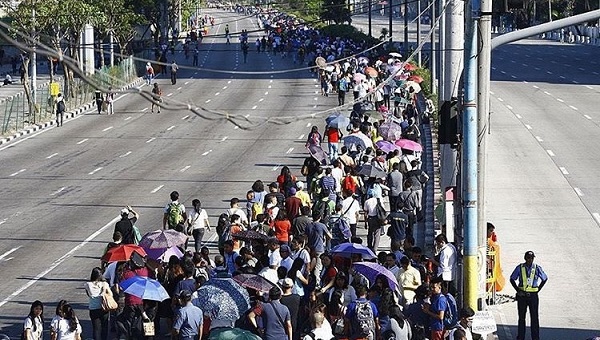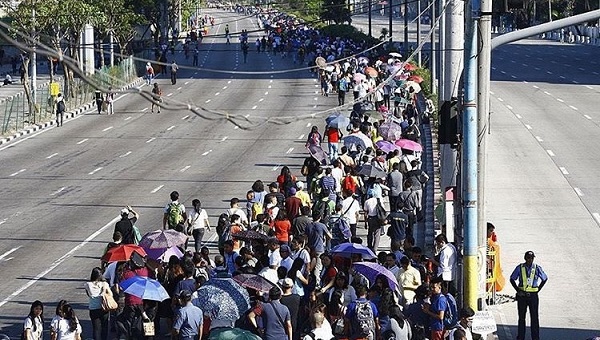
By ELLEN T. TORDESILLAS
THE monstrous traffic jam last Monday that caused thousands of people to walk to their destinations under the sweltering heat of the noonday sun shows the disastrous gap between noble intentions and miserable realities on the ground.
That’s what makes many people resist embracing the Asia Pacific Economic Cooperation which is holding its 23rd summit today and tomorrow at the Philippine International Convention Center in Pasay City.
This week is an opportunity for the Philippines to shine in the world stage. (This is the second time that the Philippines hosted APEC Leaders Meeting. The first was in 1996 under Pres. Fidel Ramos. It was held in Subic.)Twenty-one leaders of the Asia Pacific Economies or their representatives are in Manila to discuss how to realize the vision they laid down in 1989 which is to support sustainable economic growth and prosperity in the Asia-Pacific region.

Aside from the 21 leaders accompanied by their senior officials and media that number some 8,000, there are also the some 800 business leaders in the region working hand-in-hand with the governments to achieve the APEC objective of making the lives of the 2.8 billion people in the Asia Pacific region better through easy flow of goods, services, investment, and people across borders.
That’s the reason for the stringent security measures in Metro Manila. Places where the leaders are staying and roads where they will be passing are closed to the public.

The public understand the restrictions and are willing to adjust their lives for what they know are short-term inconveniences. What they demand from the government are common sense measures.
The President declared Nov. 18 and 19 non-working holiday and suspended work in government offices in the National Capital Region on Nov. 17 through 20. Nov. 16, Monday, was not included in the work suspension. Thus workers in Metro Manila still went to work.
I was one of those who walked more than three hours the almost five kilometer stretch from Coastal Road to Baclaran last Monday when our bus decided to return to where it came from- Las Pinas- after more than one hour of not moving because Roxas Boulevard was already closed to non-APEC cleared vehicles.
Aquino and his advisers should have listened to the travails of the commuters. One has a small business in Sta. Cruz and she had to go to her office that day because it was payday. She said if she didn’t give the employees’ salary that day, they would have no money for the next three days because the next working day would be on Friday. What if the employee needed money for the milk of her baby or for the rental of the house?
Another commuter from Cavite and she was going to Binondo. She sells printers ink and she has to collect on paydays. She was panting under the noonday heat and she was beginning to get worried because she is hypertensive.
Many said since authorities would be closing major streets in Metro Manila, they should have declared Monday a non-working holiday so they would have also adjusted their activities.

I met 71-year old Lourdes Lopez from Caloocan who visited her daughter in Las Pinas. She had difficulty walking. Good thing Loisa Castro, an employee of the Philippine National Bank, Macapagal Avenue, assisted her. She said , “Sana may shuttle van man lang.”
Emmanuel Miro, head of the MMDA’s Task Force Apec, was asked about providing shuttle buses to stranded commuters. He dismissed the idea saying that would only cause more road congestion. “The most advisable thing to do is to walk,” he said.
Talk of callousness.
Leaving people displaced by government’s not-so-well-thought out measures to their own devices does not seem to fit in APEC’s desire for an “inclusive” economy.
In fact, this year’s APEC theme is “Building Inclusive Economies, Building a Better World.”
The term “inclusive” signifies embracing everybody. Foreign Undersecretary Lula del Rosario, chair of the APEC2015 Senior Officials Meeting said “We see economic growth through the lens of inclusiveness … not only in trade and business facilitation, but also on issues which affect the very fabric of the man on the street.”

President Aquino himself told the CEOs that he looks forward to “a connected, synergized Asia-Pacific…where no one is left behind.”
As he was saying this in the splendid ballroom of the Makati Shangrila, thousands of hapless commuters were hiking under the heat of the scorching sun left behind in the government’s frenzy for an “inclusive” APEC.
